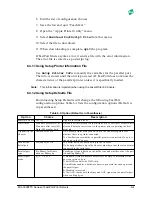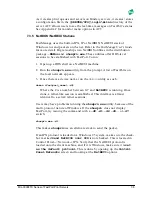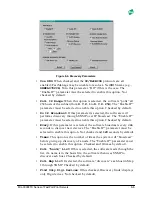
MIL-3000FTX Series of FastPort Print Servers
6-7
1. Edit the following two lines to the “Setup Defaults” file. Insert the
binary name within the parentheses:
Parallel Port Type (
Binary hp) // can be: No Binary or Binary
adobe or Binary hp.
Serial Port Type (
Binary hp) // can be: No Binary or Binary
adobe or Binary hp.
2. For each port (serial or parallel), choose one of the options:
No Binary / Binary adobe / Binary tek / Binary hp.
3. Download the new setup file with the “Apple Printer” utility.
4. Reboot FastPort.
5. Verify the new setting in
Chooser
. Non-binary printers appear as
before. Default names are:
FP
XXXXXX-par-PS
FP
XXXXXX-ser-PS
All queue names are based on the parallel ports name. If a printer is named
“Alpha” and is configured for binary support for serial/parallel, the
following printers appears in
Chooser
:
Alpha
Alpha
—
PS Binary
Alpha
—
S
Alpha
—
S
—
PS Binary
Note:
Only use the
Namer
utility to change regular names. The name of the PS Binary
printer does not need to be changed directly.
Before a standard Adobe PostScript Level 2 printer can be used with the
binary encoding, the following PostScript fragment may need to be
downloaded to the printer as a separate file:
^D (%Parallel_NV%)
<</Password (0) /Interpreter/PostScript/Protocol/Binary>>
setdevparams
^D
This file is on the Advanced Utilities as
force_parallel_ binary
and
force_serial_binary
. For serial printers, replace
Parallel_NV
with
Serial_NV
. This needs to be done once per port during the life of the
printer. For HP printers, FastPort automatically encode PS binary if that
mode has been configured by setting the parallel port type to binary
hp
.
















































